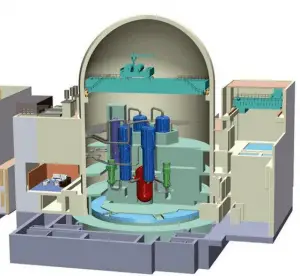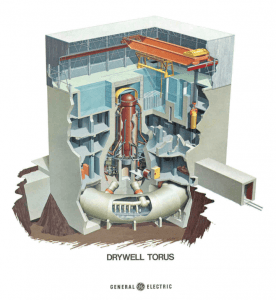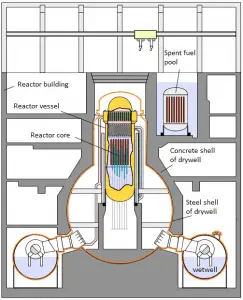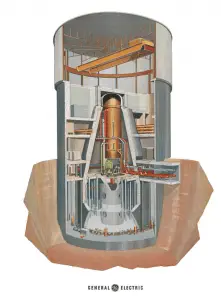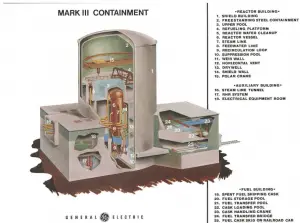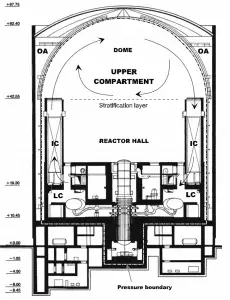Types of Containment Buildings
- Full pressure dry containment (PWR). A dry containment envelope is a steel shell or a concrete building (cylindrical or spherical) surrounding the NSSS (Nuclear Steam Supply System). During normal operation, a prescribed negative pressure is maintained by a fan cooling system. Pressure suppression and the heat sink can be accomplished during accidents by a fan cooler system or a containment water spray system.
- Full pressure double-wall containment (PWR). This containment usually consists of a primary containment shell (a steel or concrete shell, basically cylindrical or spherical in shape) and a secondary confinement building (a concrete shell surrounding the primary containment). The principle of the primary containment is similar to that of the full pressure dry containment. The secondary confinement building protects the systems and components against external postulated initiating events and captured leakage from the primary containment.
- Bubbling condenser containment building (PWR). The bubbling condenser containment system uses a concept for the suppression pool or suppression pools. The high-pressure steam following LOCA or MSLB conditions is directed through submerged tubes into pools of water. In these pools, the steam is condensed, and this acts against the pressure increase.
- Ice condenser containment building. The ice condenser containment system uses the concept of ice chambers. The high-pressure steam following LOCA or MSLB conditions is directed into chambers containing baskets filled with ice. In these chambers, the steam is condensed, and this acts against the pressure increase.
- BWR containment buildings. Modern boiling water reactors (BWRs) have no steam generators so that the reactor coolant system is more compact than that of pressurized water reactors (PWRs). The containment building can be correspondingly smaller. On the other hand, BWRs also utilize the large heat sink inside the containment building for energy removal during reactor isolation events. This is because slightly radioactive steam forms excess energy, which cannot be released into the atmosphere. The BWR containments vary widely depending on certain reactor designs. The major containment designs are the Mark I, Mark II, and Mark III. The BWR containments usually consist of the following parts:
- Drywell. A drywell houses the reactor coolant system.
- Suppression pool or wetwell. A wetwell is a suppression chamber, which stores a large body of water, and therefore it is commonly called the suppression pool.
- Containment envelop. The Mark III containment leaks a tight, cylindrical steel containment vessel. This vessel surrounds the drywell and the suppression pool.
The purpose of the drywell and the wetwell (suppression pool) is to reduce the pressure if LOCA or MSLB occurs. In these cases, the steam from a leak enters the drywell and is directed through submerged tubes into the water of the suppression pool (wetwell), where it condenses, and the pressure in the drywell is reduced.
- Pressurized containments in heavy water reactors. In comparison with LWR containments, most of the HWR containment buildings are accessible. Therefore ventilation is needed for maintaining working conditions. Some units use a single unit suppression, which consists of:
- A containment envelope comprises a prestressed, post-tensioned concrete reactor building.
- A large dousing tank, which is elevated around the building dome, and a powerful spray system.
- A long term containment cooling system
Some units use a multi-unit vacuum building, where more containment envelopes (more units) are connected to a common vacuum building with powerful energy and pressure suppression system.
